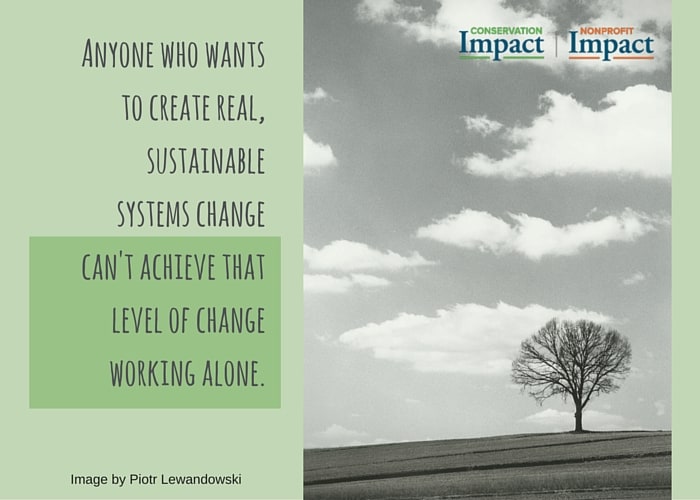
Strong Organizations = Strong Partnerships
For 18 years, we have had been privileged to work with over 650 organizations and agencies. Our Conservation Impact clients come to us in hopes of building stronger organizations in order to increase their conservation results. Through Nonprofit Impact, clients work with us to strengthen their programs, coalitions, and agencies so that they can better achieve population-level health outcomes.
While our Conservation Impact and Nonprofit Impact clients are focused on different types of goals, none of them do their work in isolation. For example, there is a long history of partnership between public agencies and nonprofit organizations working together for the protection, management, and enjoyment of public lands. And in public health at every level, partnership is embedded in just about every program and project as a primary strategy for creating healthier communities and people.
Partnerships like these have become even more important in recent years, especially for those working on complex public health, public lands, or environmental issues. Indeed, anyone who wants to create real, sustainable systems change – instilling an environmental ethic or creating a culture of healthy behaviors, for example – cannot achieve that level of change working alone.
Increasingly our clients are paying attention to the strength and productivity of their partnerships – not just of their organization or agency. And this is critically important. Strong organizations make strong partnerships; and strong partnerships make strong organizations.
Strong Organizations Make Strong Partnerships
Latching onto a partner because they can compensate for a weakness of yours doesn’t work well in human relationships. And it doesn’t work well in partnerships between organizations either.
Partnerships work best when each party comes to the table as strong, vibrant and focused; unequivocally clear about what value they bring and how their assets can be optimized through the partnership. What we call strategic partnerships – that is meaningful partnership based upon important shared goals – are relationships between equals. They are interdependent relationship based on two wholes working together to achieve goals that they cannot effectively achieve by acting alone.
Strong Partnerships Make Strong Organizations
Partnerships are meaningful when they are, well, meaningful. There is a world of difference between the multitude of stakeholders, publics, or markets an organization has and its few, significant strategic partnerships that it must have in order to achieve shared goals.
Strong strategic partnerships are about quality, not quantity, and they shouldn’t be entered into lightly. Whether or not an organization enters into a strategic partnership should be a deliberate decision about if partnerships are the best way to build a stronger organization and achieve results.
The 3 I’s
Organizations and agencies that work with strategic partners, whether in conservation or in public health, will recognize that partnerships are integral, that they need to be integrated and that it is about innovation.
Integral
Partnerships take time, investment, commitment, understanding, compromise, and communication. Just ask anyone who is happily married! You only have the time and energy to invest in partner relationships, so only enter into strategic partnerships that are absolutely integral to your success.
Integrated
If a partnership is integral, then you need to integrate it throughout your organization or agency. Not only is it impossible to maintain a strategic partnership long term when just a few individuals interact with the partner, but keeping the partnership separate from your core functions make it much less effective and productive.
Innovative
Ultimately, strategic partnerships are about innovation – creating something new, and something bigger, than either party could on their own. Interestingly in both conservation and public health, the “something new” is fundamental systems change. And you can’t achieve systems change incrementally. In requires a systems approach that is often only possible when working in partnership with others.
That is the beauty of partnerships.
Conclusion
Strong organizations produce strong partnerships, and strong partnerships produce strong organizations. In today’s complex world, partnerships are no longer a “nice to have” but are integral to success and achieving systems change results.
For more information on how to build strong organizations and strong partnerships, see:

